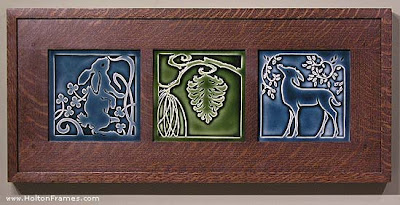Geoffrey Agrons is a good customer and a superb photographer. We just framed this set of his photos printed on handmade Japanese paper, and they present a good opportunity to demonstrate two important lessons of framing design: framing contemporary photographs close, and individualized frame design. Geoffrey sent seven photos, most of which are of the Cape May area during last winter's huge snow storm. (The large one here is of a woods in Ireland.)
For a slide show, with larger images, click
here.
We decided to frame them all in walnut, a wood we frequently choose for photographs, first, because of the suitably native cool color—we used a black wash to better match the sepia ink color on most of them—and second, because of its tight grain and smooth texture, which is consistent with the smooth surface of photographs.
For the first image, above, I chose a slope for the overall profile since it was appropriate to the deep perspective as well as the slope of the ground and the angles formed by the roots. A cove terminating at the top with a fine bead made an ideal form to suit the trees and roots half-embedded in the earth.
What fascinated me in this image was the staccato rhythm of the line of fencing in contrasting with the soft forms of snow. So that's what I echoed in the frame, using fine 1/6" "quirks," or steps, and a soft cove at the sight edge. Here's a detail of the frame profile.
A flat profile was chosen for this picture because of the flat horizon. It's true that there is a deep perspective in this image, but the horizontal quality seems to be stronger. (If more of the stream could be seen meandering away toward the horizon, that might have swayed me to go with a slope.) A fine line, its 1/8" width in proportion to the sharp lines in the photos, was raised near the sight edge, and a gentle ovolo (convex form) at the sight edge to echo the banks of the stream and the snow.

This frame is a similar flat profile with a raised line, but with a cove at the sight edge. I love the way the grain of the walnut echoes the clouds.
This frame is a good example of the importance of line proportion because it's essentially a frame that's been an old standby for us, the Eastwood—a flat profile with a narrow step at the sight edge and a broader step at the back edge. But the line proportions formed by these steps had to be just right for this picture, since it's so simple, and those line proportions that have become standard for the Eastwood were too wide for this image, so we adapted them to suit this specific photo.

For this color photo, a slope was chosen to echo the angle of the snow. I used a carved panel just outside the sight edge to echo the sense of coarse texture.
Finally, for this extremely subtle image I used a profile with a suitably very subtle curve down at the sight edge. The frame's basically flat, but coves up toward the back edge with a quirk and a bead at the back edge, providing definition while also echoing the cylindrical form of the posts.
For more on framing photographs close, see my Picture Framing Magazine article (link to the pdf "Close Framed Photographs," in the right column of my page, "Further Reading,"
here).
Geoffrey will be showing these pieces and more this September at he
New Jersey Audubon Nature Center in Goshen, NJ.
Again, click
here to view these in a slide show (with larger views).









































